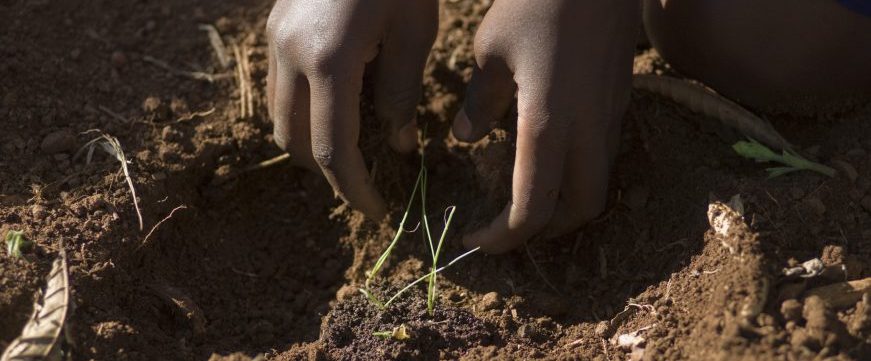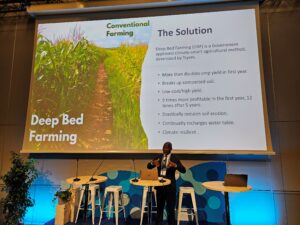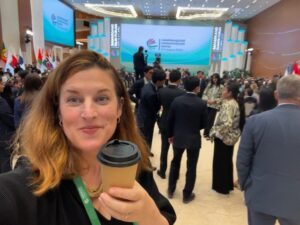- SIWI – Leading expert in water governance
- /
- Latest
- /
- How to feed close to 10 billion people
How to feed close to 10 billion people
With two billion more to feed in 35 years, we must de-carbonize food production, writes Jennifer Jun, Programme Manager of International Policy, in this blog post. At the upcoming UNFCCC Bonn Climate Conference SIWI will spotlight solutions to make that possible, with renewable energy, improved water efficiency, and new technological innovations.

By 2050, the world’s population is estimated to reach 9.8 billion people, with two-thirds living in cities and with unsustainable consumption patterns. Even at 7.6 billion today, we face deep challenges in meeting the demand for sufficient and nutritious food for all. How will this escalating demand for food and unchecked food waste tendencies further affect our natural resources and the environment? And how should we continue to grow in a sustainable and just manner?
In order to feed two more billion people in the next thirty-five years, we will need to, on the one hand, ramp up our food production, and on the other, bring down food waste. This has two significant consequences. First, agriculture today comprises a third of the energy expended around the globe. From the primary food production phase to the harvest phase to the transportation and delivery of food to the consumers, all stages of the agrifood chain require tremendous amounts of energy. Unfortunately, agriculture is a drain on another crucial resource – water. Today, the agriculture sector takes up 70 per cent of global water resources, and by 2050, there will be an increase of 15 per cent in water withdrawals.
When taking climate change into account, the picture becomes even more grim. Not only are agriculture, water, and energy vulnerable to the effects of climate change, they also play a role in exacerbating it. For instance, the agrifood chain has historically relied heavily on conventional energy sources, especially fossil fuels. This is one of the reasons why agriculture claims 22 per cent of all greenhouse gases emitted each year. With exacerbated climate conditions, there is increased risk that crops are plagued by drought, floods, disease, etc.
The evident interconnections between agriculture, water, and energy need not point only to a downward spiral. Thanks to two global roadmaps that lay out a vision for a better future for human development and the health of the planet, we can look to the nexus as a wellspring of solutions and innovation that can speed up our progress on the global agendas. The UN Agenda for Sustainable Development spells out seventeen goals and 169 specific targets to be reached by 2030. In particular, exploring the interlinkages between SDG 6 (clean water and sanitation), SDG 7 (affordable and clean energy), SDG 12 (sustainable consumption and production), SDG 14 (life below water), and SDG 15 (life on land) opens up the possibility that climate and water wise solutions can be found in the agrifood chain. The UNFCCC’s Paris Agreement on climate change is an unprecedented effort to curb the rise of global temperatures by requiring all signatory countries to put forward nationally determined contributions (NDCs) to lowering greenhouse gas emissions and to adapting to the impacts of climate change. Almost all the proposed NDCs cite water as a key component of their adaptation efforts and more than 85 per cent of developing countries refer to agriculture in their mitigation contributions, with an even higher percentage among developed countries.
SIWI will continue to be engaged and advocate for the vital role of water in all areas of sustainable development and its deep interconnections with important areas such as agriculture and energy.
In the face of climate change and a rocketing demand for food, decision-makers should focus the next decade of action on the sustainable development goals and climate action contributions with a view of innovative solutions found in the water-food-energy nexus. To share these insights with national decision-makers and civil society representatives, SIWI will be present at the UNFCCC Bonn Climate Conference this week. Attended by high level delegates from countries, both party and non-party to the Paris Agreement, SIWI is one of the lead organizations contributing to the Technical Expert Meetings on Mitigation (TEM-M) whose theme this year is “Energy – off-grid and decentralized energy solutions for smart energy and water use in the agri-food chain.” We will spotlight various solutions aimed at de-carbonizing the primary food production phrase through renewable energy, water efficiency, technological innovations, and traditional and indigenous knowledge.
Among the featured best practices is aQysta, a developer of hydro-powered pumps for farmers looking for reliable and affordable irrigation year-round. We were inspired by their story at the 2018 World Water Week and believe that it’s a good example of the use of sustainable technologies for smarter agriculture. Another example we’ll be highlighting is the Spowdi solar-powered water distribution system, a water pump connected to a small solar panel that can replace traditional diesel pumps for irrigation. This pump benefits smallholder family farms in the rural areas of developing countries with abundant solar access. Also hailing from Sweden is the Ericsson Weather Data System, which provides real-time rainfall data with granular time and spatial resolution thanks to microwave links. This innovative tool offers a glimpse of the future of precision farming, improving planting, smarter fertilization and harvesting cycles. The availability of accurate weather forecasting and rain modelling is also promising for developing micro-insurance for farmers as a protection against flooding, drought, and disease outbreaks.
Equipped with real-world examples, we would like to illustrate at the Bonn Climate Conference that there is a real opportunity for farmers to implement climate smart, water and food secure solutions. For starters, farmers should consider sustainable irrigation using solar, wind, hydropower and low carbon fuels; using smart inputs of water and fertilizers, both inorganic and organic, to maximize synergies of energy, water and land use; applying precision management at every stage of farming, for instance with the help of big data; securing support for when environmental extremes occur, and wherever possible, building on traditional knowledge and techniques. As for the policymakers and institutional representatives in the room, they should walk away with a stronger commitment to enabling these solutions at the national and local levels by building capacity and increasing the financial resources needed to scaling them up and multiplying them.
Ahead of significant milestones coming up this year in the climate community, such as the UN Climate Summit in New York in September 2019 and the COP25 in Chile in December 2019, SIWI will continue to be engaged and advocate for the vital role of water in all areas of sustainable development and its deep interconnections with important areas such as agriculture and energy. It is where these issues cut across one another that we can identify points of action, traditional knowhow, innovation, and higher ambition.
Most recent

SIWI joins the winning consortium to lead EIT Water – Europe’s new innovation community tackling water challenges
- Freshwater and ecosystems/biodiversity
- Source-to-Sea
- Swedish Water House
- Water in landscapes

Building resilience in Sweden’s ports
- Cities
- Water and climate
- Waterfront

Forests, trees and the water cycle: why agriculture depends on healthy landscapes

Restoring landscapes and strengthening green water flows through innovative finance

Bridging Climate and Water for a Greener Central Asia



